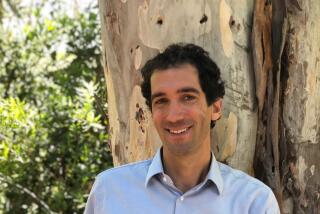Book review: ‘The Red Garden’ by Alice Hoffman
- Share via
The Red Garden
A Novel
Alice Hoffman
Crown: 275 pp., $25
“The Red Garden” is a fantastical history of Blackwell, Mass., from 1750 to the present, replete with intermarried families, melancholic bears and altruistic mermaids. If you have trouble with bears and mermaids, this just isn’t your kind of book, for Alice Hoffman is a star in the burgeoning field of fairy-tale literary fiction.
A novel-in-stories, “The Red Garden” presents fables in dated, chronological order, beginning with William Brady’s catastrophic expedition to the Berkshire frontier — “He led them in circles for the full month of October … fumbling through the wilderness until an early blinding snowstorm stopped their progress.”
Nothing much happens in Blackwell; everything happens in Blackwell.
Johnny Appleseed plants a tree that saves villagers from starvation. Emily Dickinson visits from nearby Amherst. Men disappear into the Union forces in the Civil War. Electricity is introduced, killing an elephant in the process. The WPA sends a writer to uncover folklore. World War II imposes home front sacrifices. Hippies settle in, unsettling everyone else. Here, in her 28th book, Hoffman records Berkshire history through the generations in much the same way that she celebrated Cape Cod in her 2004 novel, “Blackbird House.”
This is a magical world of premonition, coincidence, superstition, visitation and shape-shifting: “Blackwell was deep in Berkshire County, where the weather was mysterious and the people were equally unpredictable. Several of the inhabitants were descendants of the founding settlers, families who had intermarried often enough so that many of the women had red hair, with mercurial tempers that suited their coloring. The men were tall and quiet and good at most everything. All the dogs in town were collies, smart, fast dogs, used to herding cows and sheep; they answered to an individual whistle as if they were birds instead of dogs and understood songs as easily as words.”
Narrative intimacy and authority are apparent in Hoffman’s aphoristic sentences. “He had already failed at everything he had tried; she hadn’t yet begun to live,” Hoffman says of the explorer Brady. Or, of the town’s earliest days, she writes: “Once you’d come to Blackwell and tasted those apples, you would never need to go anywhere else.” And when World War II casts its shadow, people there “went to bed earlier than they used to, frightened of the darkness beyond Blackwell.”
Although her characterization is stronger on archetype than on human idiosyncrasy and some plots are contrived, Hoffman’s spirit of place shines. The Look-No-Further apple tree and the Eel River are major presences, if not characters in themselves. The mountains are adversaries; the gardens tell stories. Then there are the black flies, the plague of dramatic legend and irritating dailyness.
Loss, grief and struggle are familiar Hoffman themes. Here, children have fatal accidents; parents die young; siblings perish from the flu; bears are shot; the beautiful woman becomes an eel; a devoted lover disappears; a girl betrays her only friend. Then there is the foundational 1816 tale of Amy Starr, who transforms into an apparition for centuries to come. “They stood together in the shallows of the river, the little girl’s sopping body between them, their breath hot and fast while Mary sobbed and Yaron did his best to comfort her. The dog was quiet now, down on his haunches, his eyes never leaving the child he’d been sent to find. Amy’s clothes were frozen stiff, and she was heavy as a block of ice.”
Hoffman exhibits her usual curiosity about and sympathy with outcasts — the suicidal widow, the lonely girl ashamed of her blue-collar family, the reclusive young wife of the ancient fisherman, the left-behind lesbian, the woman who loves a bear, the disfigured giant obsessed with the town beauty: “He came one night before she went back to school, even though the snow was deep. He stood outside and watched her through the window as she read a novel. She was beautiful and far away even though he was standing in her yard.”
Whether “The Red Garden” leaves you haunted or maddened, you have to nod to Hoffman’s artistic daring and nimble imagination.
Miner teaches at Stanford University. Her most recent novel is “After Eden.”
More to Read
Sign up for our Book Club newsletter
Get the latest news, events and more from the Los Angeles Times Book Club, and help us get L.A. reading and talking.
You may occasionally receive promotional content from the Los Angeles Times.









